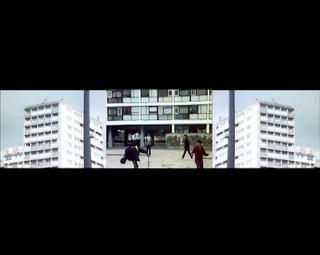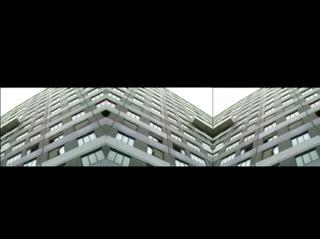

Matrix of Rule
H.Mur, Nithya Nagarajan
1 Nov 2021–31 Jan 2022
Matrix of Rule (2021) considers the varied forms of labyrinths and racial membranes constructed to contain bodies we deem surplus, ineligible and disposable, on a local and planetary scale.
Matrix of Rule (2021) takes the experience of Algerian-French psychogeographer Abdelhafid Khattib as its point of inquiry. Set against the backdrop of the North African curfew introduced in 1958 banning Arabs on Parisian streets and following multiple police arrests and assaults, Khattib is forced to abandon his dérive undertakings in the area of Les Halles. Despite being a contemporary of Guy Debord and an active member of the Situationist Art Movement, Abdelhafid Khattib's experience was briefly addressed in an appended note but not considered to the degree it challenged Debord's Theory of the Dérive and Psychogeography (1958).
In 'Matrix of Rule,' I appropriate Debord's filmic methods of recontextualizing, splicing and interlacing found footage with theoretical texts. Cameroonian philosopher Achille Mbembe's theorising guides us to consider, both locally and on a planetary scale, the varied forms of labyrinths and racial membranes constructed to contain bodies deemed surplus, ineligible and disposable.
'What time is it?'
‘The civil must be separated from the political and defined in its own right as the interest that citizens display in themselves, in others, in their shared forms of coexistence, as well as in the world that they create and nurture.’
(Azoulay, 2012).
‘What time is it?’ These words repeated in the voice of the Cameroonian philosopher, Achille Mbembe, ‘what time is it?’ disarms the viewer into a false sense of security at the very outset of this experimental video work. These four words have seeped into popular parlance in Australia where the major cities have been navigating ongoing lockdowns and shifting local, state and international border closures. Collapsing the systems of our convenient fictions, the work invited me to consider the implications of our immediate environs: the incarceration of Indigenous peoples, the vilification of bla(c)k youth, the policy of offshore detention and the human rights breach on Melbourne’s public housing towers in so called Australia in the context of planetary entanglements.
Encountering Matrix of Rule is an exercise of watching space become occupied with complexity. H Mur’s three channel installation reveals the violent tethering between power and exclusionary spaces - ‘in the north, in the south, in the south of the north, in the north of the south, in the east’s east…everywhere’.
In something of a departure from Mur’s previous works, the artist builds the film’s affect solely through editing and citation. The architecture of constriction on the outer channels is a harrowing transmission. The centre channel is complicated by slippages of the flesh and subjectivity of subaltern bodies. The artist’s use of jump cuts, rapid montages, graphic matches, subtitles and blackouts embrace the plausibility of range in bodies deemed other - in intimacy, in play, in wander, in celebration, in liberation, in protest - acts that burst out of the seams of constriction of their limits.
Walk down a street (alone) in a body that is yours ---
--- but isn’t yours alone
From the very beginning, the viewer is denied access to the interiority of the material world of these spaces. The centre frame is deterritorialized and reinvigorated by alternate spatial and temporal configurations. In the theatre, this is akin to world building.
L ~ i ~ n ~ k arms and push forward with an intentional non-compliance
feeltheedgesofyourskin
s | y | n | c step
I’m reminded of black feminist scholar Tina Campt's call for a methodology of ‘listening to images’. She posits, ‘how do we conjugate our relationship of being to the future?’. Mur contends with what it means to attend intensively to the bla(c)k present, and indeed, black presence. The desperate search for these images in the archives initially turned up nothing, forcing them to resort to the use of resolutely compromised images, freely available in open access, compressed and flexible formats. ‘Poor images’, as German filmmaker Hito Steyerl famously references them, images whose sole purpose serve as backdrops or footnotes to the racist forces ascendent all around us.
In rendering bodies visible and invisible all at once, the marginalised in Matrix of Rule clap back to carceral machinations of the state. Our point of view is consistently punctured by this brutality.
Move your head from
side to side.
R Left
i Partially Left
g
h
t
R
i
g
h
t
Disappropriating the aesthetics of Debord’s practice, Mur intercepts it with their signature capacity to bear witness to how subaltern bodies document and represent their own experiences in relation to the wider ramifications of colonial violence. In arresting montages, Mur exposes the vulnerability of black bodies walking in broad daylight, the monotony of extreme isolation and the ability for collective care, not because of, but despite the state.
Field recordings of birds, direction of winds and children playing haunt the score sonically, and the drums have been stripped back to singular pulses making for a disconcerting listening experience, deliberately decontextualized by composer Marco Cher Gibard.
What struck me most is the final interview of the young girl. When asked how long she has lived here, she responds, ‘All of my life’. These words register moments before we watch the towers destroyed by explosion.
_Skate____ on______ thin___________ ice______________________________________
Adopting the storytelling strategy of false endings, Mur returns to the present day perimeters of Australia’s detention facilities on Christmas Island. This commitment to relationality in the work is a bleak reminder of the indefiniteness of offshore detention, and the casualties of Australian refugee policies. The cyclical echoes of containment reverberate as we behold the immediacy of Christmas Island’s ring fenced registration area through the matrices of rule internationally.
On a call to Mur, I remark on their radical agenda to suture the archive with living memory. I say, ‘I read this work as encryption (citing Legacy Russell’s Glitch Feminism) where you are inscribing the plaintext of these found images and archival footage with the ciphertext of their lives and associations’. Mur responds, dryly,
‘This work is propaganda’.
Nithya Nagarajan.
References:
Azoulay, A 2012, Civil Imagination: A Political Ontology of Photograph, Verso, London, New York.
Campt, T 2017, Listening to Images, Duke University Press, Durham.
Mbembe, A 2017, Rethinking Democracy Beyond the Human 15 Dec. Available at:https://www.youtube.com/watch?v=A_k3YIupGok(accessed 15 October 2021)
Russell, L 2020, Glitch Feminism: A Manifesto, Verso, London, New York.
Steyerl, H 2009, ‘In Defence of the Poor Image’, e-flux Journal, issue 10. Available at:https://www.e-flux.com/journal/10/61362/in-defense-of-the-poor-image/
Mur, H 2021, Conversations with Mur. September 13 and October 24.
Gibard, M 2021, Email correspondence with Marco Cher Gibard. October 26.


Blindside Satellite programs are presented online and onsite at the gallery as on public screens at Bunjil Place, Narre Warren; Harmony Square, Dandenong; Liverpool, Sydney and Beenleigh, Queensland.
The project examines notions of public space, specifically the public square and what it means for art to occupy these spaces and connect physically disparate audiences through a collective experience.
This program takes place on the land of the Wurundjeri people of the Kulin Nation. We recognise that sovereignty was never ceded - this land is stolen land. We pay respects to Wurundjeri Elders, past, present and emerging, to the Elders from other communities and to any other Aboriginal or Torres Strait Islanders who might encounter or participate in the program.
H.Mur is a Sudanese educator, community worker, and visual artist based in Narrm. Across photography, projection and the moving image, they are interested in the everyday poetics and politics of bodies on the margins of margins.
Nithya Nagarajan is an artist and curator whose practice adopts movement as a system of inquiry into the sacred, the sensual and the decolonial.
Priya Namana is an Indian contemporary artist, curator and producer living and working on the unceded lands of the people of the Kulin Nations in Naarm. Her practice is enquiry-based and asks emergent questions in the present to probe into possible future ecologies.

